Imaging the spine in arthritis-a pictorial review
- PMID: 22347946
- PMCID: PMC3259357
- DOI: 10.1007/s13244-010-0061-4
Imaging the spine in arthritis-a pictorial review
Abstract
Spinal involvement is frequent in rheumatoid arthritis (RA) and seronegative spondyloarthritides (SpA), and its diagnosis is important. Thus, MRI and CT are increasingly used, although radiography is the recommended initial examination. The purpose of this review is to present the typical radiographic features of spinal changes in RA and SpA in addition to the advantages of MRI and CT, respectively. RA changes are usually located in the cervical spine and can result in serious joint instability. Subluxation is diagnosed by radiography, but supplementary MRI and/or CT is always indicated to visualise the spinal cord and canal in patients with vertical subluxation, neck pain and/or neurological symptoms. SpA may involve all parts of the spine. Ankylosing spondylitis is the most frequent form of SpA and has rather characteristic radiographic features. In early stages it is characterised by vertebral squaring and condensation of vertebral corners, in later stages by slim ossifications between vertebral bodies, vertebral fusion, arthritis/ankylosis of apophyseal joints and ligamentous ossification causing spinal stiffness. The imaging features of the other forms of SpA can vary, but voluminous paravertebral ossifications often occur in psoriatic SpA. MRI can detect signs of active inflammation as well as chronic structural changes; CT is valuable for detecting fracture.
Figures



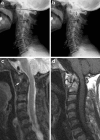



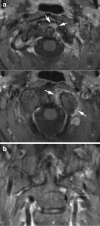




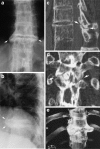



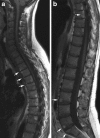



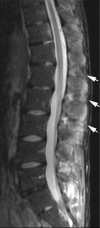
Similar articles
-
Imaging of cervical spine involvement in inflammatory arthropathies: a review.Pol J Radiol. 2021 Nov 20;86:e620-e629. doi: 10.5114/pjr.2021.111363. eCollection 2021. Pol J Radiol. 2021. PMID: 34925651 Free PMC article. Review.
-
Use of dynamic magnetic resonance imaging to detect sacroiliitis in HLA-B27 positive and negative children with juvenile arthritides.J Rheumatol. 1998 Mar;25(3):556-64. J Rheumatol. 1998. PMID: 9517781
-
Cervical spine involvement early in the course of rheumatoid arthritis.Semin Arthritis Rheum. 2014 Jun;43(6):738-44. doi: 10.1016/j.semarthrit.2013.12.001. Epub 2013 Dec 12. Semin Arthritis Rheum. 2014. PMID: 24444595 Review.
-
[Epidemiology and prognostic aspects of ankylosing spondylitis].Radiologe. 2004 Mar;44(3):209-10, 212-6. doi: 10.1007/s00117-004-1025-9. Radiologe. 2004. PMID: 15287356 Review. German.
-
Cervical spine manifestations of rheumatoid arthritis: a review.Neurosurg Rev. 2021 Aug;44(4):1957-1965. doi: 10.1007/s10143-020-01412-1. Epub 2020 Oct 10. Neurosurg Rev. 2021. PMID: 33037539 Review.
Cited by
-
The role of radiography in the study of spinal disorders.Quant Imaging Med Surg. 2020 Dec;10(12):2322-2355. doi: 10.21037/qims-20-1014. Quant Imaging Med Surg. 2020. PMID: 33269230 Free PMC article. Review.
-
Clinical and MRI outcome of cervical spine lesions in children with juvenile idiopathic arthritis treated with anti-TNFα drugs early in disease course.Pediatr Rheumatol Online J. 2017 May 15;15(1):38. doi: 10.1186/s12969-017-0173-1. Pediatr Rheumatol Online J. 2017. PMID: 28506237 Free PMC article.
-
Spondylitic psoriatic arthritis presenting as acute urinary retention.BMJ Case Rep. 2014 Apr 30;2014:bcr2013202383. doi: 10.1136/bcr-2013-202383. BMJ Case Rep. 2014. PMID: 24789155 Free PMC article.
-
The Features of Children with Juvenile Idiopathic Arthritis with Cervical Spine Involvement in the Data from a Retrospective Study Cohort.J Funct Morphol Kinesiol. 2025 Feb 15;10(1):68. doi: 10.3390/jfmk10010068. J Funct Morphol Kinesiol. 2025. PMID: 39982308 Free PMC article.
-
Ectopic bone formation and systemic bone loss in a transmembrane TNF-driven model of human spondyloarthritis.Arthritis Res Ther. 2020 Oct 6;22(1):232. doi: 10.1186/s13075-020-02327-4. Arthritis Res Ther. 2020. PMID: 33023659 Free PMC article.
References
-
- Kim DH, Hilibrand AS. Rheumatoid arthritis in the cervical spine. J Am Acad Orthop Surg. 2005;13(7):463–474. - PubMed
-
- Riew KD, Hilibrand AS, Palumbo MA, Sethi N, Bohlman HH. Diagnosing basilar invagination in the rheumatoid patient. The reliability of radiographic criteria. J Bone Joint Surg Am. 2001;83(2):194–200. - PubMed
LinkOut - more resources
Full Text Sources
Research Materials
